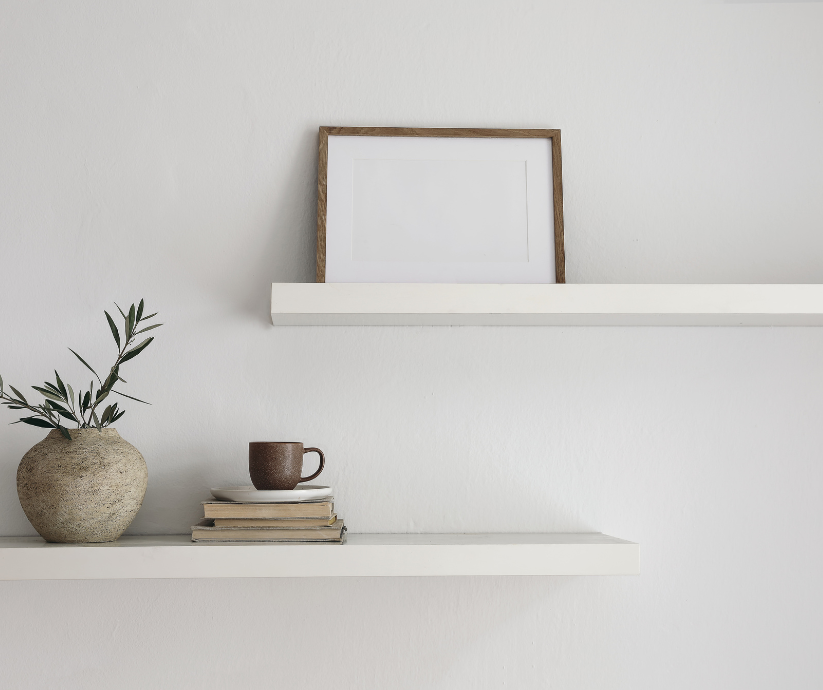Floating shelves have become a popular choice among homeowners seeking a sleek, minimalist solution to declutter and brighten their living spaces. Unlike traditional shelving units that can overcrowd rooms, floating shelves offer an aesthetically pleasing means of maximizing vertical storage. They effortlessly blend into various design themes, from modern and contemporary to rustic and farmhouse. Additionally, they’re especially beneficial in smaller living areas, apartments, or studios, as they provide ample storage without compromising floor space.
Building your own floating shelves can be both cost-effective and fulfilling. This straightforward DIY project often involves basic tasks such as measuring, cutting, and drilling—making it approachable for even those with limited experience. Whether you favor stylish, white-washed finishes or the warm touch of natural wood textures, the design possibilities are extensive. Beyond aesthetics, floating shelves serve practical purposes in kitchens, bathrooms, or entryways, helping free up counters and surfaces. With the right tools—such as a power drill, wood saw, measuring tape, and level—it’s simple to tailor the shelves’ length, thickness, and finish to perfectly match your home’s interior.
Preparation and Planning
Before you start the building process, careful preparation and strategic planning are key steps to guarantee your project’s success. Begin by deciding precisely where you’ll install the shelves. Consider locations that offer both visual appeal and functional utility. Then, take meticulous measurements of the designated areas. Not only will accurate dimensions ensure stability and security, but they also allow you to confidently proceed with material acquisition.
When planning your shelves, reflect on the items you’ll display or store, as this directly impacts shelf dimensions and materials. Selecting a cohesive color theme or matching your shelves with existing decor will contribute to a seamless interior design aesthetic. Compile a thorough checklist of necessary supplies—such as lumber, screws, floating brackets, sandpaper, paint, or stain—to avoid inconvenient mid-project errands to the hardware store.
Additionally, prioritize safety in your preparations. Protective goggles, gloves, and dust masks are must-haves to minimize potential risks. Allocate adequate time and avoid rushing through the steps to ensure each phase is completed thoroughly and safely. This thoughtful preparation will pave the way to creating attractive, functional floating shelves that elevate your home’s ambiance.
Choosing the Right Materials
Selecting the appropriate materials for constructing floating shelves significantly influences your project’s durability and aesthetic appeal. Wood choices such as plywood, pine, or premium hardwood each offer distinct advantages that cater to differing requirements. Plywood is affordable and versatile, ideal for simpler projects or first-time builders. Pine’s workability makes it a reliable choice for customizable shelves, whereas hardwoods like oak, walnut, or cherry stand out due to their remarkable longevity and luxurious appearance.
Beyond wood choice, consider whether pre-cut panels or custom-cut boards suit your project needs best. While pre-cut panels simplify construction, they might come with increased costs. Equally important is selecting robust and compatible hardware, ensuring secure and stable installation. Traditional metal floating brackets are popular due to proven durability and ease of use. Additionally, high-quality wood screws specifically rated for floating shelves should be part of your toolkit.
Explore eco-friendly alternatives, especially if sustainability is a priority. Using reclaimed or certified sustainable lumber can significantly reduce environmental impact while providing a unique aesthetic charm. Regarding finishes, test paint or stains on scrap wood beforehand to verify compatibility and appearance. Investing thoughtfully in moderately priced yet durable materials will guarantee lasting satisfaction from your completed shelves.
Cutting and Assembly
Accurate cutting and thorough assembly form the backbone of a successful floating shelf installation. Start by clearly marking cut lines—use a square tool for precision and consistency. Always prioritize safety by wearing goggles and gloves, and ensure materials rest securely on a stable surface when preparing to cut.
Once you’re comfortable proceeding, perform standard cross-cuts to obtain the precise length for each shelf. If constructing a hollow-box design, secure the top and bottom panels first, then proceed to connect the side boards. Following this specific order boosts sturdiness and structural integrity, ensuring your shelf stands the test of time.
Drilling pilot holes is an indispensable step, significantly mitigating the risks of wood splitting or damage during assembly. Apply wood glue along seams before fastening with finishing nails or screws, reinforcing these critical joints. Regularly test alignment as you assemble the structure, enabling adjustments on the fly to achieve a flawless fit. Once assembled, sand down surfaces thoroughly, removing any rough areas or splinters. This finishing step transforms your shelf project from an amateur effort into a piece with professional-quality craftsmanship.
Installing the Floating Brackets
Mounting floating brackets might initially seem daunting, but precise execution ensures a durable, attractive shelf system. The installation relies heavily on secure placement into wall studs; a reliable stud finder tool is crucial for precisely pinpointing their locations. Determine ideal shelf heights by considering practicality and aesthetic impact, marking your placements accordingly.
Verify bracket positioning with a spirit level, ensuring brackets align horizontally to maintain visual harmony. Drill pilot holes into studs based upon instructions recommended by bracket manufacturers; carefully done, this protects your walls from potential damage. Anchor these brackets with strong screws designed to reliably carry the shelf’s weight and any displayed items.
Once securely in place, carefully position shelves onto brackets. Perform stability checks by gently applying downward pressure or arranging lightweight objects initially—this small test ensures confidence before fully loading shelves. If using concealed brackets that could reveal hardware underneath, camouflage them using matching paint or finishing touches to maintain an elegant visual element. With attention to detail and patience, your floating shelf bracket installation will offer both sturdiness and sleek aesthetics to refresh your living space.
Finishing Touches
Your floating shelf endeavor reaches completion by refining and perfecting details, turning your initial woodworking project into a polished masterpiece. Begin using fine-grit sandpaper to meticulously smooth every corner and edge, eliminating sharpness or unevenness. Sanding provides a clean canvas, perfect for applying paint or stain treatments.
When applying chosen finishes, consistency is key. Whether painting, staining, or using clear protective coats, multiple thin layers will achieve even coverage and optimal aesthetics. Allow sufficient drying time between coats to solidify resilience and appearance. Your finish choices can complement existing design themes or intentionally contrast for heightened effect.
Optional enhancements like routered decorative edges or adding small LED strip or puck lights can create striking visual focal points, particularly at night. Additionally, conceal visible screw heads to refine the project’s professional appearance; wood filler and gentle sanding after drying effectively hide these spots. Inspect closely for remaining flaws, drips, rough textures, or imperfections, attending promptly to necessary adjustments. Taking extra time for finishing ensures your DIY floating shelves transition from functional storage utilities into cherished home features.
Create Beautiful and Functional Spaces with DIY Floating Shelves
Successfully creating and installing your own floating shelves provides immense satisfaction, transforming your home’s empty walls into practical and beautiful showcases. With careful preparation, wise material selections, meticulously accurate assembly, and attentive finishing touches, your shelves will reliably withstand daily use. They become the perfect canvas to proudly display treasured souvenirs, meaningful art, or decorative accents.
This satisfying woodworking project serves not only as an immediate boost to interior functionality and aesthetic appeal but also sets the foundation for expanding your DIY skills in future endeavors. To continually enjoy your craftsmanship, simple upkeep—including routine dusting, non-abrasive cleaners, and occasional refinishing—keeps shelves attractive and durable. Embarking on this journey enriches your home’s environment and your personal expertise, ultimately proving rewarding in both practicality and creative fulfillment.









